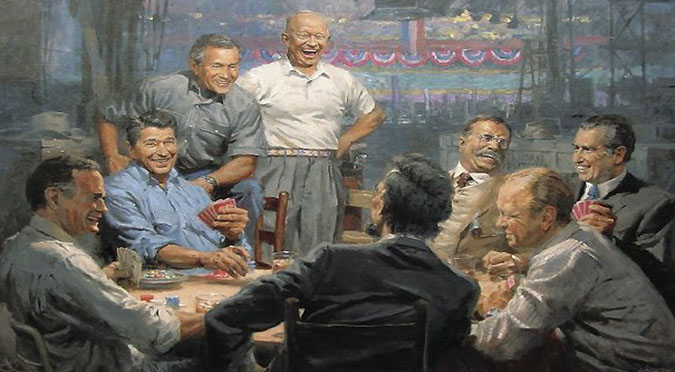
PRESIDENTIAL Pros & Cons – Part Eight
July 7, 2017
Richard the Third (and the War of the Roses)
August 16, 2017The Battle of Little Big Horn – June 25th, 1876
“Hurrah boys, we’ve got them! We’ll finish them up and then go home to our station.”
– Custer’s last words
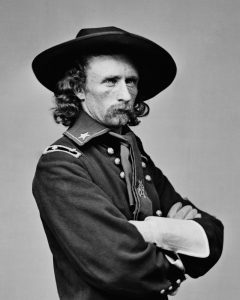 General George Armstrong Custer was born in Ohio in 1839. He graduated from West Point in 1861, but just barely. While there, Custer was known for devoting most of his energy to pranks, earning him extra guard duty on the weekends. After graduating (last in his class btw), he joined up with the Union Army and became a cavalry commander during the Civil War where he fought in the First Battle of Bull Run, the Siege of Yorktown, and even Gettysburg! Through his incredibly brave actions, he earned the rank of Major General, becoming the Army’s youngest general.
General George Armstrong Custer was born in Ohio in 1839. He graduated from West Point in 1861, but just barely. While there, Custer was known for devoting most of his energy to pranks, earning him extra guard duty on the weekends. After graduating (last in his class btw), he joined up with the Union Army and became a cavalry commander during the Civil War where he fought in the First Battle of Bull Run, the Siege of Yorktown, and even Gettysburg! Through his incredibly brave actions, he earned the rank of Major General, becoming the Army’s youngest general.
In addition to being known for his reckless bravery (and his class clown antics), Custer also made a reputation for his flamboyant behavior and paying extra attention to his appearance. He often wore a fancy velvet black uniform with a large sombrero, red scarf and even scented his long golden locks with cinnamon oil!
In 1867, General Custer was court-martialed for leaving his troops in Kansas to visit his wife, Libbie. He was suspended of rank and pay for a year, but was reinstated 10 months later when the Cheyenne tribe started stirring up trouble…

Conflicts between the US government and Native Americans had been an ongoing problem since before the United States were… well, united. Relations with the native tribes obviously weren’t helped at all by the events of the War of 1812 and especially Andrew Jackson’s Indian Removal Act (aka The Trail of Tears), but things got gradually worse when American settlers began to further encroach on their land and started breaking treaties left and right. It all came to a head when frontiersmen found gold in the Black Hills of the Dakota Territory. This of course got the attention of the US government – the only problem was that the Black Hills just so happened to be sacred ground to the Lakota tribe.
In 1873, Lt. Col. Custer was sent in to protect a railroad survey team from the Lakota-Sioux. Then in 1874, Custer led an expedition into the Black Hills where he and his Native American scout, named “Bloody Knife”, found gold deposits along a creek. Custer’s announcement led to a full-on gold rush. An influx of settlers led to the creation of several nearby frontier towns, including Deadwood – or as Obi-Wan would call it: a hive of scum and villainy.

President Ulysses S. Grant attempted to keep miners out of the region, but was pressured into securing the Black Hills from the Lakota. Eventually, Congress attempted to purchase the land for $25,000 and offered to relocate the tribe to Oklahoma. The Great Plains Indians weren’t having any of it. A Lakota Chief named Spotted Tail said, “You speak of another country, but it is not my country; it does not concern me, and I want nothing to do with it. I was not born there … If it is such a good country, you ought to send the white men now in our country there and let us alone.”
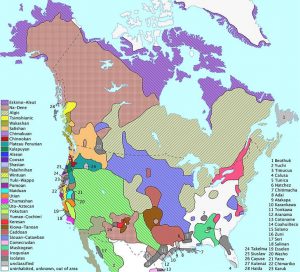
North America: pre-“white people”
The government failed in attempting to make a new treaty with the Lakota, so they decided to take the land by force… again. This time though, the Northern Cheyenne and Lakota-Sioux were ready for a fight. The Great Plains Indians united with thousands of warriors as guys like Crazy Horse took up arms against the US Army to defend their home in what became known as the Great Sioux War.
I think it goes without saying that Custer was a huge self promoter, between his “adventures” (stealing land from the natives) he wrote several (embellished) articles about his exploits on the frontier. In his time, Custer was known as an American hero, but the truth of the matter is that he was more poser than badass. When it came to tactics, Custer’s whole M.O. was to wait until the tribe’s warriors were out hunting and then attack their village, capturing their women and children to use as bargaining chips.
One particularly abhorrent raid occurred on November 27th, 1868 – in retaliation for a series of coordinated attacks against settlers in Kansas and Oklahoma, the military sent in the 7th Cavalry to conduct reconnaissance. Lieutenant Colonel Custer located a large Cheyenne village near the Washita River, but instead of following orders and doing a little recon, Custer decided to attack.
Unfortunately, it was the wrong village.
In the middle of the night, without any provocation, without even making sure they were the correct tribe, Custer and his men viciously attacked a peaceful defenseless village of men, women and children without remorse. And what’s worse? These particular natives were already living on a reservation!
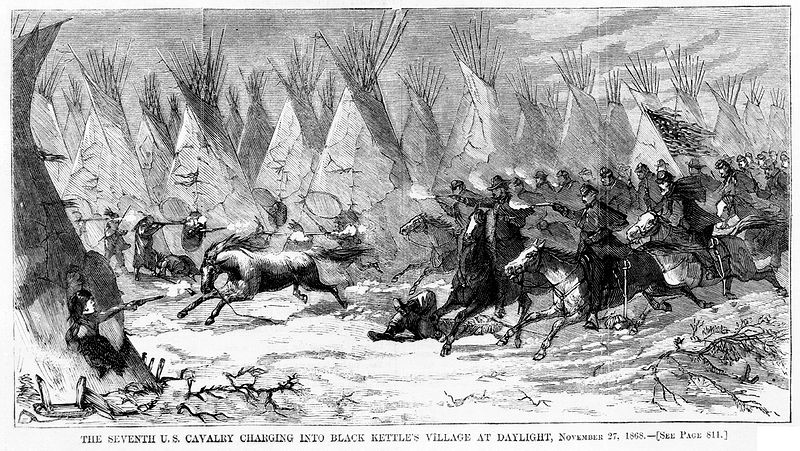
Leeerrrroooy Jeeeennnkins!
The Lakota, Arapaho and Northern Cheyenne decided they’d had enough of Custer’s douchebagery, so decided to team up, under the leadership of Crazy Horse. During the summer of 1876, the Great Plains tribes came together in the Montana Territory, for a spiritual summer festival known as The Sun Dance. It was there that Sitting Bull proclaimed a vision of “soldiers falling into his camp like grasshoppers from the sky.” As fate would have it, Custer and his army were en route.
As the 647 members of the 7th Cavalry approached, Custer’s troops spotted an encampment 10 miles out near Little Bighorn River. Initially he planned a sneak attack for the following morning, but his Indian scouts pointed out that the tribe might see them coming and scatter if they waited. One of his interpreters, Mitch Bouyer, tried to warn Custer, “General, I have been with these Indians for 30 years, and this is the largest village I have ever heard of.” Without waiting to get a better assessment of the situation, General Custer decided to charge ahead. He split his forces into three groups so that they could capture them from all sides.
Things did not go according to plan.

Custer and his battalion expected to find a few hundred natives who would attempt to escape like they always had before. Instead, what Custer found was as many as 3,500 well-armed warriors ready to defend their ground! What happened next was not so much a last stand as a massacre. 268 American troops were killed, 49 others were wounded and 6 of which later died from their injuries. It was a total blood bath. George A. Custer himself bit the dust, but there are conflicting account as to how exactly that went down.
Many claimed responsibility after the fact, including White Bull, Brave Bear, and some guy called Flat Lip. There was even a legend about a heroine named “Buffalo Calf Road Woman” who struck the final blow against Custer, knocking him off of his horse. According to another account he was shot early in the battle and fell of his horse, before things descended into sheer chaos on (what is now known as) Custer Hill. And yet another version of the story says that Custer and his men were ambushed while crossing Little Bighorn River. One second hand account even says that his two bullet wounds – one to the head and one to the chest, were from his own gun. Either way though, one thing that is definitely not up for debate is that General Custer, along with two of his brothers, a brother-in-law and his cousin were all killed during the botched attack.
Custer’s body was later discovered… with an arrow shoved somewhere I can’t talk about.

Custer’s (gruesome) death turned him into a martyr that rallied others against the Great Plains Indians. For a long time after, Custer was used as a propaganda piece, portrayed as a selfless hero who valiantly stood his ground against impossible odds, like the Texans at the Alamo, but today many people believe that Custer ultimately got his just desserts. He might’ve been brave, but he was also extremely reckless.
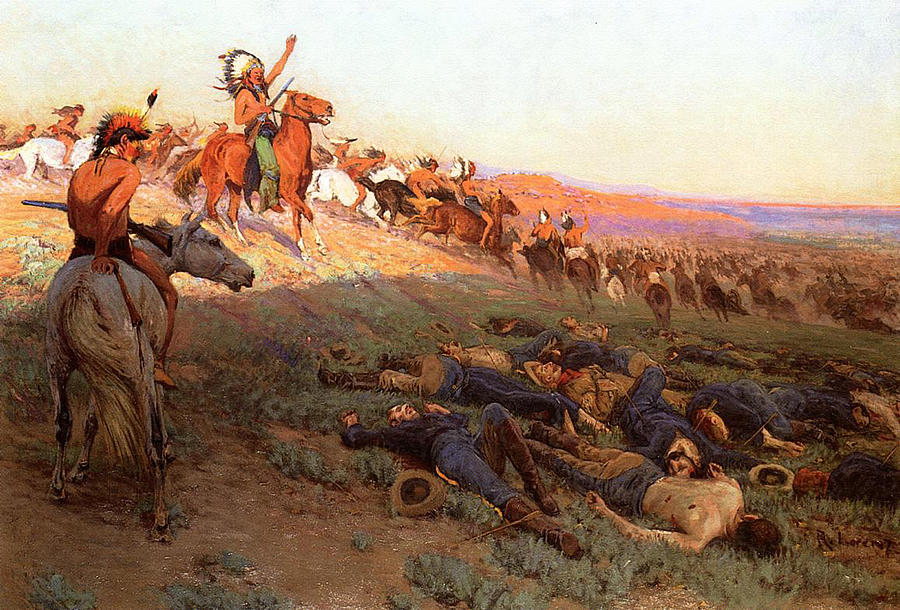
Years later, after being forcefully deported to the Dakota Reservation, many American Indians began to protest in a peaceful resistance movement known as Ghost Dancers – I imagine it was kind of like Woodstock, a hundred years before Woodstock was a thing.
Many of the surviving soldiers of Little Big Horn wanted revenge, so when Colonel James W. Forsyth and a battalion of soldiers surrounded an encampment of Ghost Dancers near Wounded Knee creek, things quickly spiraled out of control. When an old, deaf, Native American man named Black Coyote, refused to give up his rifle, the troops opened fire on the camp.
84 men, 44 women, and 18 children were massacred for absolutely no reason at all.
Oh and the Black Hills that the entire conflict was fought over? That’s where Mount Rushmore is now…
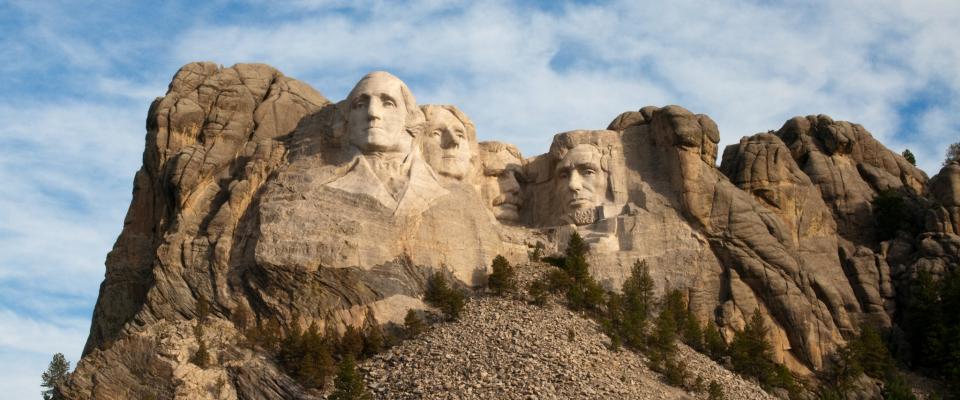
Erik Slader
Thanks for reading! If you’re a fan of the blog, be sure to listen to the Epik Fails of History podcast and check out my all new “EPIC FAILS” book series – available now wherever books are sold!
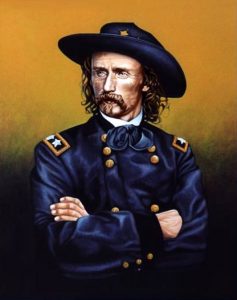 Presidential Pros and Cons – Part 1
Presidential Pros and Cons – Part 1
CIVIL WAR: Clash of the Ironclads!
Sources:
“Custer, Sitting Bull and the Battle of Little Big Horn: The Last Stand” by Nathaniel Philbrick
Confluence of Events podcast: “Custer’s Last Stand”
https://en.wikipedia.org/wiki/Great_Sioux_War_of_1876
http://www.history.com/news/10-things-you-may-not-know-about-george-armstrong-custer
historynet.com/ten-myths-of-the-little-bighorn
historynet.com/george-armstrong-custer-changing-views-of-an-american-legend

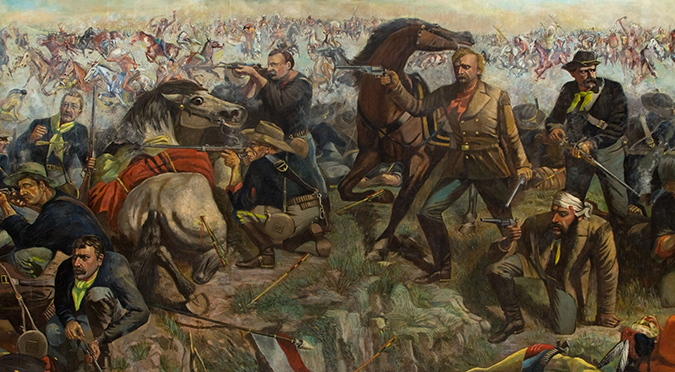




2 Comments
You put forth quite a biased view here. Lt. Col. Custer wasn’t in overall command nor did he make policy. He followed orders. His actions at the LBH were disastrous but if he had secured the non combatants he would have won substantially. He obviously wanted to get control of the situation before the Natives scattered. He could have been court martialed if he waited until the next day and the Natives were leaving or gone.
If you study how he positioned his soldiers it’s clear that they were not arrayed for serious battle. He wasn’t attacking the village in the traditional sense and wanted the least casualties on both sides.
What commander who dies in battle doesn’t get what they deserve? They are warriors and play for keeps. Custer made probably one bad mistake that cost him everything and that is misunderstanding the sheer size of that camp. Even so, had Benteen been quick and showed up where they were waiting for him quickly things would have been different. Maybe he wouldn’t have been wiped out. Maybe Benteen’s troopers would have all died also. So many great events turn on the simplest of factors. Faulting a man doing his job as he knew how to do it is a little chickenshit. I don’t even like George Custer but to paint him as some coward who chose to make war on women and children is not fair and to smear a person because they lost an engagement is ridiculous.
Wow, you really make some excellent points! I have to admit, I’m (obviously) not an expert on Custer, so I might’ve been a bit harsh on the guy. Obviously the blog does have a little bit of a slant, because its focusing on the great blunders of history. Heck, I’ve covered figures that I really admire, but I try and focus in on their mistakes and shortcomings as lessons to be learned from, with a (hopefully) humorous approach. So ego, hubris, greed, etc – a lot of the basic human failings that we all contend with. I may have to revisit this subject on the podcast at some point, would it be cool if I read your feedback? Thanks for writing! 🙂